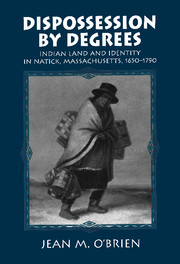Book contents
- Frontmatter
- Contents
- List of illustrations
- Acknowledgments
- Prologue: “My land”: Natick and the narrative of Indian extinction
- 1 Peoples, land, and social order
- 2 The sinews and the flesh: Natick comes together, 1650–75
- 3 “Friend Indians”: Negotiating colonial rules, 1676–1700
- 4 Divided in their desires, 1700–40
- 5 Interlude: the proprietary families
- 6 “They are so frequently shifting their place of residence”: Natick Indians, 1741–90
- Conclusion
- Index
1 - Peoples, land, and social order
Published online by Cambridge University Press: 04 August 2010
- Frontmatter
- Contents
- List of illustrations
- Acknowledgments
- Prologue: “My land”: Natick and the narrative of Indian extinction
- 1 Peoples, land, and social order
- 2 The sinews and the flesh: Natick comes together, 1650–75
- 3 “Friend Indians”: Negotiating colonial rules, 1676–1700
- 4 Divided in their desires, 1700–40
- 5 Interlude: the proprietary families
- 6 “They are so frequently shifting their place of residence”: Natick Indians, 1741–90
- Conclusion
- Index
Summary
Awaunaguss, suck. English-man, men.
This they call us, as much as to say, These strangers.
Strangers
In the New England colonial encounter, Native peoples and the English who came to their lands confronted each other as strangers. To be sure, Native peoples had been engaging in sporadic relations of exchange with various Europeans throughout the sixteenth century, which provided Native peoples with a bedrock of selective information about Europeans. Likewise, the English consumed the burgeoning literature on the “New World” that served up fact and fancy about aboriginal peoples and their lands, some of which grew out of English efforts to gain a foothold in the European invasion of the Western Hemisphere. These accumulated bodies of partial and incomplete knowledge that resulted from actual or recorded experiences partly conditioned the shape and interpretation of interactions between Indians and the English. Still, “strangeness” remained, and in early encounters, peoples with little intensive experiences with one another struggled for comprehension. Not surprisingly, in their effort to understand the differences between themselves, they made frequent recourse to their own cultural categories to craft explanations about how the others saw, and lived, their lives.
A crucial aspect of the colonial encounter involved a collision between peoples who held deeply ingrained and dramatically divergent notions about how a properly constituted social order should be composed. The culturally different notions about the social order ranged from what constituted “good manners” to the larger question of the divine source of social relations, and touched on just about everything else in between.
- Type
- Chapter
- Information
- Dispossession by DegreesIndian Land and Identity in Natick, Massachusetts, 1650–1790, pp. 13 - 30Publisher: Cambridge University PressPrint publication year: 1997
- 1
- Cited by

